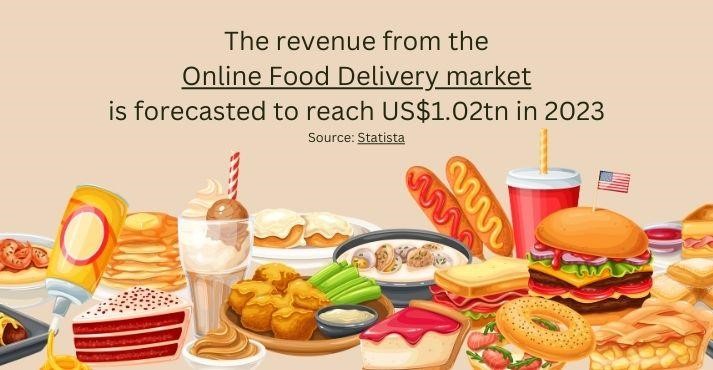Online food delivery services have changed the way the world eats.
The digital revolution has redefined the world’s culinary landscape, coupled with the increasing use of smartphones, lack of time, growing urbanization, and expanding working population.
The pandemic further accelerated the online food delivery market. With continuous growth and development in e-commerce, the Food and Beverage Industry even outpaced the traditional brick-and-mortar business model.
Consumers are attracted to online ordering since it is much more convenient, comfortable, and at their leisure. The busy lifestyle and comprehensive options to choose from have further pushed consumers to adapt to online ordering.
With all the changes and trends, the food delivery industry continues to explore new opportunities and address the challenges occurring with time.
Current Landscape of Online Food Delivery Industry

The landscape of online food delivery has transformed and experienced unprecedented growth since the pandemic. As lockdowns and quarantine regulations forced people to stay home, grocery and meal delivery demand increased dramatically.
In response to accelerating demand, online food delivery companies grew substantially during and post-pandemic, and it hasn’t stopped moving forward.
The revenue in the Online Food Delivery market is forecasted to reach US$1.02tn in 2023. The food delivery market size will grow at a CAGR of 12.78% (2023-2027), resulting in a projected market volume of US$1.65tn by 2027.
In the Grocery delivery market, a revenue growth of 22.2% is anticipated in 2024. In the Meal delivery market, users are expected to reach 2.5bn users by 2027.
The rapid economic growth growth of the Asian region has changed the world’s economic power. Asia Pacific users of online food delivery are expected to grow by more than 50 percent by 2027.
Due to the high population level, the Asia Pacific region is the largest user region, accounting for nearly two-thirds (64 percent) of all users worldwide.
As the quick service food-delivery ecosystem grows and expands, its economic structure is still evolving.
Key Players in the Online Food Delivery Industry

Competitors turn fierce to capture the food delivery market share and battle against international giants. As they consolidate to gain maximum market share, changing consumer habits and business models will determine which stakeholders win or lose as the industry develops.
The food delivery service market share is divided among the top players, including:
- Uber Eats
- DoorDash
- Grubhub
- Just Eat Takeaway
- Zomato
- Deliveroo
- Grab Holdings Inc.
- Delivery Hero SE
- Foodhub
- GoPuff
Technological Advancements
Technology is pivotal in food delivery, revolutionizing how we order and receive meals. With the advent of appealing, user-friendly apps and tech-enabled driver networks, foodtech is constantly evolving.
With the rising number of mobile users worldwide, the number is expected to reach 7.49 billion by 2025. Fueling the growth, mobile apps and websites enabled convenient online ordering, tracking, and payment options.
According to a survey by Statista, 80 percent of business leaders acknowledged that personalized experiences led to increased consumer spending, and 62 percent highlighted the positive impact on customer retention.
Therefore, AI-driven recommendations can help the Food and Beverage sector to enhance the personalized experience, offering customers tailored menu suggestions based on their past orders and preferences.
Moreover, data analytics can further optimize planning and predicting customer preferences, enhancing service quality.
Consumer Behavior and Trends
As a response to many factors, consumer behavior in the context of global food delivery is constantly changing. In recent years, more people have been utilizing the digital channel.
The way restaurants and food service businesses operate has changed because of this shift in consumer behavior. The food industry is perplexing, as consumers are demanding more personalization.
Let’s dive into the emerging consumer behavior and trends transforming the online food delivery industry.
Rise of Cloud Kitchens
A cloud kitchen, known as a dark kitchen, ghost kitchen, or virtual restaurant, allows you to quickly expand your restaurant into multiple locations with minimal upfront investment. These kitchens operate without a dine-in facility and focus solely on takeaway or home delivery services.
The global cloud kitchen market is forecast to reach 112.53 billion U.S. dollars by 2027. The primary focus of cloud kitchens is to facilitate the commercialization of any restaurant and make their food available in a particular location.
Cloud kitchens enhance customer experience by maintaining service quality as more delivery-only options become available.
Growth of In-House Food Delivery Platforms
Apart from the third-party delivery services, restaurants and hotels are focusing on setting up in-house food delivery platforms. The main reason for adopting this is to take advantage of the food delivery services and cater directly to customers.
Grocers and restaurants understand that it is essential to deliver excellent service every time, and outsourcing delivery services to a third party can damage their reputation if standards are not met.
For example, a restaurant in Singapore, Kelly Je Seafood, has an in-house delivery service for customers. It can help them maintain customer satisfaction and its brand reputation.

Source: KELLY JIE SEAFOOD
Prevalence of Third-Party Food Delivery Apps
Third-party food delivery apps are giving consumers more choices and convenience than ever before. Consumers can order from restaurants listed on these third-party food apps with a single tap on their mobile phone.
Let’s explore why third-party food delivery apps are essential for your food and beverage business:
- Consumers expect your restaurant to be listed on these delivery platforms.
- Your restaurant becomes discoverable amongst new customers within your area.
- Reduces the burden of food delivery on restaurants and provides value-added services
- Integrating your restaurant’s POS and management systems with these services is more accessible.
- Outsourcing your delivery to a third-party company means lowering your food and beverage costs.
- These apps act as an unofficial seal of approval for most consumers.
More Demand for Grocery Delivery
According to the Asia Food and Business Statistics, the demand for grocery delivery is increasing due to digitalization, surging internet use, escalating urbanization, the growing working population, and changing preferences.
The Grocery Delivery market Worldwide is set to achieve a staggering revenue of US$627.30bn by 2023.
Furthermore, this market segment is expected to display a robust compound annual growth rate (CAGR) of 16.11% between 2023 and 2027, resulting in a projected market volume of US$1,140.00bn by 2027.
As we progress, online grocery delivery is here to stay and will become a much more significant part of the e-commerce industry.
Large and small chains of supermarkets and beverage suppliers are focusing on expanding their grocery delivery services. Businesses in the food and beverage sector must be able to keep pace with these evolving preferences.
Use of Data Analytics to Improve Customer Satisfaction
The global big data analytics market will grow with a compound annual growth rate of almost 30 percent in the coming years, with revenue reaching over US$ 68 billion by 2025 from around 15 billion U.S. dollars in 2019.
The market is expected to grow significantly over the coming years as businesses have recognized the significance of gaining insight into customer data in real time and improving their experience with the brand.
Food retailers, restaurant owners, and entrepreneurs starting a food business must understand the importance of using customer data to improve efficiency, reduce operation costs, and improve brand reputation.
Challenges Faced by Food Delivery Services

As online food delivery growth occurs, the industry faces several challenges. Food businesses are still acquiring a substantial number of new customers each day.
Shifting customer preferences requires constant adaptation to changing trends and demands. Unstable market prices make cost management a constant concern.
Adhering to food quality standards is essential for maintaining trust and adopting sustainable packaging for conscious consumers.
While managing cost-effective food warehousing to prevent food handling and facing the threats by key players in the industry, complexities are increasing.
Let’s look deeper at these challenges faced by food delivery services.
Rising Operational Costs
Rising operational costs pose a significant challenge for food delivery services, impacting profitability and sustainability. Expenses related to labor, transportation, and technology infrastructure can strain budgets.
Therefore, businesses must focus on ways to streamline operations and maintain cost-effectiveness while delivering quality customer service. For example, outsourcing food delivery to third-party apps reduces operational and overhead kitchen costs.
Fewer Loyal Customers
Food and beverage businesses must focus on activities that retain customers and help them increase restaurant brand awareness. As consumer preferences evolve, the loyal customer base has reduced and can decline if service and food quality aren’t maintained.
Adhering to the Food Quality Standards
Due to increasing food delivery demands, restaurants and cafes must maintain the utmost quality while maintaining the service. It can be achieved through maintaining service standards and following food safety practices to help prevent biological hazards.
For example, if the food served in-house at the restaurant and delivered at home has the same quantity, quality, and taste, consumers will become repeat customers. If there is any loophole in the quality, it becomes easier to retain customers, and it can also cause damage to the reputation.
Online Food Delivery Market (FAQs)
Which segment accounts for the most significant online food delivery market share?
According to the statistics published by Global Data, the platform-to-consumer market segment is expected to account for 39.9% market share in the global online food delivery market and is expected to record a CAGR of 6.6% during 2023-2027.
Who are the key players in the online food delivery market?
Key players in the online food delivery market are:
- Uber Eats
- DoorDash
- Grubhub
- Just Eat Takeaway
- Zomato
- Deliveroo
- Grab Holdings Inc.
- Delivery Hero SE
- Foodhub
- GoPuff
Closing Thoughts
As we analyze the trends and challenges in the online food delivery market, it is evident from the data that shifting consumer preferences, technological adoption, and the demand for diverse cuisine options have become paramount, necessitating constant adaptation and innovation from service providers.
Operational challenges, such as unstable market prices and rising operational costs, have pressured profit margins, emphasizing the need for cost-effective business models and efficient logistics.
The competition in the online food delivery industry is fierce, and to stay updated with the latest trends and innovations, you must attend food exhibitions to explore opportunities to expand and scale your business.












